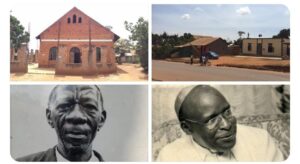
Uganda Today Edition: Kitebi The Sacred Grounds Of Unity, Church And Mosque Standing Abreast
The small church is built on land of an old Muslim family. The small mosque (which has now been replaced by a much bigger one) was only immediately separated by one house from the church, and was built by a Catholic Cardinal for the Muslim family.
In the heart of Kitebi, a bustling suburb of Kampala, Uganda, two majestic structures stand side by side, embodying the harmony and resilience of a diverse community. One is the Catholic Church of St. Joseph, its spire reaching towards the heavens, and the other, the grand Mosque of Kitebi, its minarets echoing the call to prayer. Together, they silently narrate a tale of coexistence that has transcended centuries.
The roots of this coexistence delve deep into the annals of history, back to a pivotal moment in February 1879. It was a time of turbulence, as the winds of change swept across the region of Buganda. Loudel and Amans, two Catholic evangelists, found themselves traversing the dusty roads of Buganda, spreading the gospel of Christianity. Their journey led them to the home of a prominent Muganda Muslim, Amir Ssekikubo, a man of influence and respect within the community.
Amir Ssekikubo welcomed the weary travelers into his home with open arms, offering them shelter and hospitality. Despite their religious differences, there was a sense of mutual respect and understanding that permeated the air. The boundaries of faith dissolved in the warmth of human connection, as Loudel and Amans shared their beliefs with their host, engaging in deep and meaningful conversations late into the night.
As dawn broke over the horizon, Amir Ssekikubo made a decision that would alter the course of history. He pledged to accompany Loudel and Amans to meet Kabaka Muteesa I, the revered ruler of the Buganda Kingdom. Together, they embarked on a journey that would test the fabric of religious tolerance and acceptance in the land.
Upon their arrival at the court of Kabaka Muteesa I, the atmosphere was tense with anticipation. The meeting between the Catholic evangelists and the Muslim Amir, in the presence of the king, was unprecedented. Yet, it was a testament to the spirit of unity that transcended religious divides.
Kabaka Muteesa I listened intently as Loudel and Amans shared their message of peace and goodwill. Amir Ssekikubo eloquently articulated his support for their mission, emphasizing the importance of respecting and embracing diversity within the kingdom. In that moment, religion ceased to be a barrier, and humanity emerged as the common thread that bound them together.
The events of that historic meeting reverberated throughout the land, sparking a newfound sense of unity and tolerance among the people of Kitebi. The Catholic Church and the Mosque stood as symbols of this unity, their presence a reminder of the shared history and collective aspirations of the community.
Today, as the sun sets over the horizon, casting its golden hues upon the sacred grounds of Kitebi, the echoes of Loudel and Amans’ journey still resonate. The Catholic Church and the Mosque stand as silent witnesses to the power of compassion, understanding, and acceptance in a world often divided by religious differences. In Kitebi, amidst the bustling streets and bustling markets, the spirit of unity endures, a beacon of hope for generations to come.
On their way to meet Kabaka Muteesa I upon their arrival in Buganda in February 1879, the first Catholic missionaries, Fr Lourdel (Mapeera) and Brother Amans, were received and housed by a Muslim, Amir Ssekikubo. Ssekikubo took them to the palace the following day to meet the Kabaka, where he was immediately flogged by guards – on suspicion for planning an attack on the Lubiri. Upon consultation with the Kabaka, Ssekikubo was told to bring back the ‘visitors’ after two weeks. Kabaka Muteesa I wanted to first consult the Lukiiko. That’s how Amir Ssekikubo ended up staying with the Fr Lourdel and Bro Amans for 15 days at his home in Kitebi.
Years later, in 1973, Musa Kaggwa, a son to Amir Ssekikubo, asked the Catholic Church to build a church in their family compound in honour of their contribution to the coming of Catholicism in Uganda. The church was opened in 1978.
In reciprocation for the Muslim family’s gesture, in 1980, Cardinal Nsubuga built a mosque for them close to the church. What is even more interesting is that at every annual commemoration of the arrival of Fr Mapeera and Brother Amans, Moslems and Christians here hold Mass together and afterwards, using the same pulpit, an Imam leads them in a Duwa.
I don’t know of many places where such a good example of embracing religious difference can be found.
